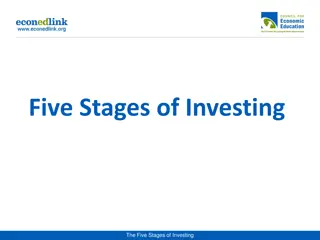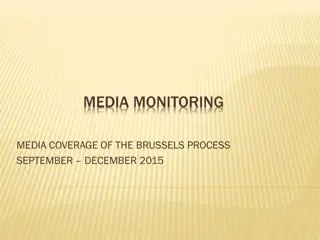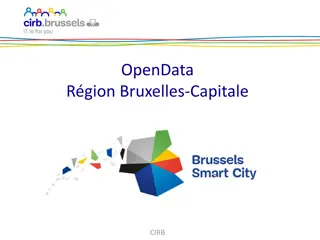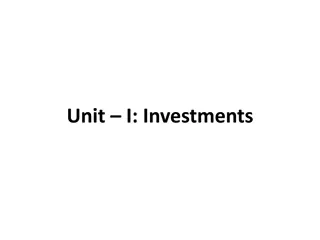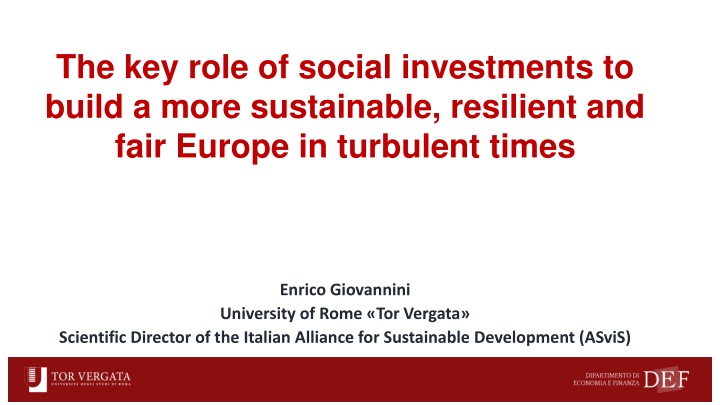
The Role of Social Investments in Building a Sustainable and Resilient Europe
Explore the key role of social investments in shaping a more sustainable, resilient, and fair Europe amidst turbulent times. Understand how social policies contribute to a stronger Europe, the concept of transformative resilience, and the importance of an integrated approach to policy-making. Discover the essential link between social investments and transformative resilience in managing crises and fostering long-term systemic change.
Download Presentation

Please find below an Image/Link to download the presentation.
The content on the website is provided AS IS for your information and personal use only. It may not be sold, licensed, or shared on other websites without obtaining consent from the author. If you encounter any issues during the download, it is possible that the publisher has removed the file from their server.
You are allowed to download the files provided on this website for personal or commercial use, subject to the condition that they are used lawfully. All files are the property of their respective owners.
The content on the website is provided AS IS for your information and personal use only. It may not be sold, licensed, or shared on other websites without obtaining consent from the author.
E N D
Presentation Transcript
The key role of social investments to build a more sustainable, resilient and fair Europe in turbulent times Enrico Giovannini University of Rome Tor Vergata Scientific Director of the Italian Alliance for Sustainable Development (ASviS)
The role of social policies to build a stronger Europe The European Pillar of Social Rights has been agreed to provide guidance in addressing common employment, skills and social challenges, and to foster upward convergence in working and living conditions in the European Union. Welfare state and social investments are vital to successfully manage our socioeconomic system in turbulent times: when a crisis occurs, inclusive and adequate social protection schemes turn out to be the most important feature in predicting the absorptive capacity of a country; before the crisis occurs, according to the transformative resilience framework adopted as new compass of European policies, social investments, active labour market policies, inclusive early childhood education and care policies, etc. are key to ensure social sustainability and to increase potential growth and employment.
How to build transformative resilience Public policies must both sustain the socio-economic system in the short run and stimulate its transformation sustainable conditions. It is necessary to design strong responses to shocks when they happen, as well as to prepare our countries to face a turbulent future. Political leaders should adopt a systemic view , based on the concepts of sustainability, when they design specific economic, environmental policies, and agree on common governance rules. towards more resilience and social and
Towards a new and integrated approach to policy making Prevention measures, aimed at reducing the incidence and size of shocks and, in the best case, to avoid them; Preparation measures, aimed at putting in place arrangements that would reinforce the necessary resilience capacities disturbance materializes; Protection measures, which are required to mitigate their impact, and to provide relief from potential deprivation or a loss of the standard of living; Promotion measures, that serve to invoke the adaptive capacity (flexibility) necessary to cope with longer and/or more severe disturbances; Transformation measures, which facilitate this process, to avoid unnecessarily abrupt changes. in case a
Social investments and transformative resilence Social policies and social investments play a vital role not only during the crises, to allow a better and quicker reaction of the socio-economic system to them, but also to build a structural transformative resilience capacity of the system, exactly how appropriate macroeconomic or microeconomic policies can both minimise the impact of a crisis on GDP, speeding up or strengthening the recovery, and produce a higher potential GDP in the medium-long term. This role has been fully recognised by the Recovery and Resilience Facility (RRF), which aims at: improving the resilience, crisis preparedness, adjustment capacity and growth potential of the Member States, by mitigating the social and economic impact of that crisis, in particular on women, by contributing to the implementation of the European Pillar of Social Rights, by supporting the green transition, by contributing to the achievement of the Union s 2030 climate targets [...]
Two key issues and three good news The available literature (UN, JRC, etc,) demonstrated the positive role of social investments and social policies to stimulate the transformative resilience of the socioeconomic system, also during the recent crises. But there are two key issues to fully understand the transmission channels: social investments and not classified as investments in the European System of National Accounts; existing analytical and econometric models are not able to capture the impact of social investments on the resilience of the socioeconomic system. On the other hand, there are three good news: the JRC has developed vulnerability and resilience dashboards ; the Commission announced the launch of a research project to improve the assessment of the RRF further developing existing models; ECOFIN invited the Commission to macroeconomic impacts. further refine tools to assess key
The new EU Fiscal Framework The objective of the new EU Fiscal framework is to ensure: effective coordination of sound economic policies of the Member States, thereby supporting the achievement of the Union's objectives for sustainable and inclusive growth and employment . To achieve this objective, the new Regulation lays down detailed rules concerning the content, submission, assessment and monitoring of national medium-term fiscal-structural plans as part of multilateral budgetary surveillance by the Council and the Commission, so as to promote sound and sustainable public finances, sustainable and inclusive growth and resilience through reforms and investments, and prevent the occurrence of excessive government deficits . Moreover, the surveillance of its implementation by the Commission must include the progress in implementing the principles of the European Pillar of Social Rights and of its headline targets, via the social scoreboard and a framework to identify risks to social convergence .
The new EU Fiscal Framework The final text states that: During the lifetime of the Recovery and Resilience Facility, commitments undertaken in the national Recovery and Resilience Plans should be duly taken into account ; the net expenditure path to be included in the medium-term plan means government expenditure net of: interest expenditure; discretionary revenue measures; expenditure on programmes of the Union fully matched by Union funds revenue; national expenditure on co-financing of programmes funded by the Union; cyclical elements of unemployment benefit expenditure, and one-offs and other temporary measures .
How will investments be defined and calculated? Some of the EU-funded policies cover social investments (education, training, fight against poverty, etc.): therefore, a MS will be able to calculate its net expenditure path subtracting them from the gross figures, while other national funds of the same type must contribute to the net expenditure path, although both expenditures aim at strengthening the structural transformative resilience of the socioeconomic system. The agreed text requires Eurostat to collect additional data concerning national co-financing of programmes funded by the EU, including those foreseen by the social cohesion fund. This opens the way to the development of additional public finance statistics able to capture the overall role of social investments, including those used to calculate the net expenditure path
How will the impact of reforms be evaluated? Recent Sustainability Analysis (DSA) to make it able to effectively support the implementation of the procedure established by the new framework. For example, the existing methodologies: could evaluate the effects on fiscal sustainability of some social investments and reforms from substantial to barely noticeable (or indeed negative, if reforms have significant upfront and ongoing costs) , and are clearly not suitable for the purposes of evaluating the growth impact of recently legislated reforms that are expected to raise output and growth through their effects on the capital stock and total factor productivity . To address this kind of issues, the authors suggest to improve the DSA and develop a new version of the current Code of conduct . studies highlighted the importance of improving the Debt
How will the impact of reforms be evaluated? Similarly, existing models are not able to evaluate the impact of investments and reform on the resilience of the socioeconomic system. In particular, they cannot estimate how reforms can change those parameters that are key to determine its response to economic, social, technological, geopolitical shocks. To overcome these limitations, existing models could be developed to be able to forecast how investments and reforms may have an impact on the indicators included in the JRC vulnerability and resilience dashboards , in particular, the social and economic ones (inequalities and the social impact of the transitions; health, education and work; economic and financial stability and sustainability).
Conclusions The aim of strengthening the structural transformative resilience of socioeconomic systems to future shocks has become a key ingredient of the new European policy frameworks. The importance of social policies and social investments to achieve this result has been fully recognised in the European Pillar of Social Rights, in the New Generation EU and in the new fiscal framework. This new way of looking at public policies is an important achievement for the EU. To effectively implement the new fiscal framework a significant effort has to be carried out to improve the analytical and statistical tools currently used by the Commission to evaluate the future impacts of reforms and investments, including the social ones, on EU economies and societies, especially on potential GDP and on structural transformative resilience.








